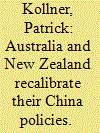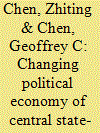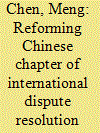|
|
|
Sort Order |
|
|
|
Items / Page
|
|
|
|
|
|
|
| Srl | Item |
| 1 |
ID:
178744


|
|
|
|
|
| Summary/Abstract |
Australia and New Zealand (NZ) have in recent years been at the forefront of the growing confrontation between the ‘West’ and China. Despite very close economic ties with China, both countries have substantially changed their approaches to dealing with the People’s Republic. In this article, I take stock of and compare the Australian and NZ recalibrations of their respective China policies, highlighting similarities as well as differences across the two country contexts and over time. It was Australian federal state actors who first embarked on a major ‘reset’ of China policy, culminating in legislation on espionage and foreign interference in 2018. After a change in government, state authorities in NZ appeared to follow Australia’s lead. However, NZ’s adjustment of its China policy has been less straightforward, more contested and overall more ambiguous. Small-state theories partly explain NZ’s more ambivalent approach. A more comprehensive understanding can be gained by reference to how NZ differs from its Tasman neighbour in terms of strategic outlook, including the paramount importance accorded to trade in its foreign affairs.
|
|
|
|
|
|
|
|
|
|
|
|
|
|
|
|
| 2 |
ID:
178741


|
|
|
|
|
| Summary/Abstract |
This research seeks to reconceptualise the process of marketizing central state-owned enterprises (CSOEs) in the Chinese petroleum industry by interpreting their institutional establishment and reconstruction, and the change in their institutional context. The enterprise reform of state-owned oil companies, and the partial market liberalization initiated in the 1980s, have not pushed the petroleum sector toward the trajectory of the neoliberal free market. On the contrary, the state’s ascendency has been reconsolidated, and the institutional practice adhered to has made market-shaping possible. The state’s role is not fixed; rather, it has varied following the marketization process of the CSOEs. The state has reconstructed its role to strengthen its authority in the market, using market mechanisms to effectively improve its power to construct a flexible economic governance structure. In such a structure, where the state and market have mutually shaped each other, the combination of the two seemingly conflicting concepts of marketization and economic security has, to some degree, fostered the development of state-owned oil companies and expanded the scale of their asset-holding. The paper contributes to the broader discussion of state-market relationships and the institutionalization of energy governance with regard to China’s integration into the global capitalist economy.
|
|
|
|
|
|
|
|
|
|
|
|
|
|
|
|
| 3 |
ID:
178750


|
|
|
|
|
| Summary/Abstract |
China’s oil investment in Central Asia from the late 1990s was not driven by energy needs or geopolitical ambitions, like many assumed. The real concern was the safety of its western boundary, while energy was used as an instrument to forge political ties with its neighbours. However, China has become one of the key geopolitical players in Central Asia after more than 20 years engagement, and many observers are keen to find out why has Beijing failed to escape the grand games while focusing on energy diplomacy? And, what is the implications of China’s new status in Central Asia on its Belt and Road Initiative (BRI)? This article attempts to answer the questions via reviewing China’s energy diplomacy towards Central Asia, from the lens of geopolitics. Focusing on China’s dealing with Kazakhstan and Turkmenistan, as well as the Russian factor, the research has revealed the main reasons that led China into the grand games: the entangling of politics and China’s energy engagements; the establishment of the Shanghai Cooperation Organization; and the changes of the pipeline map. China’s geopolitical gains have mainly made at the cost of Russia, though the latter chose to accept Beijing’s greater presence in Central Asia against the changed circumstances. The launch of the BRI scheme has amplified China’s geopolitical significance in Central Asia, but also triggered various criticisms, including the debt traps and governance-related issues. China’s dealing with the Muslims in Xinjiang was also a point of disagreement. Beijing may need to revisit its pragmatic featured diplomacy, and to take a more liberal approach to accommodate different political perspectives. With greater power potential, Beijing should bear more responsibilities to ensure peace and stability in Central Asia, together with other powers, not only for the sake of BRI’s success, but also for the interest of the mankind.
|
|
|
|
|
|
|
|
|
|
|
|
|
|
|
|
| 4 |
ID:
178737


|
|
|
|
|
| Summary/Abstract |
This article uses the international relations (IR) ‘polarity’ concept as a lens to view the shifting great power dynamics in artificial intelligence (AI) and related enabling technologies. The article describes how and why great power competition is mounting in within several interrelated dual-use technological fields; why these innovations are considered by Washington to be strategically vital, and how (and to what end) the United States is responding to the perceived challenge posed by China to its technological hegemony. The following questions addressed in this paper fill a gap in the existing literature: Will the increasingly competitive U.S.-China relationship dominate world politics creating a new bipolar world order, as opposed to a multipolar one? Why does the U.S. view China’s progress in dual-use AI as a threat to its first-mover advantage? How might the U.S. respond to this perceived threat?
|
|
|
|
|
|
|
|
|
|
|
|
|
|
|
|
| 5 |
ID:
178749


|
|
|
|
|
| Summary/Abstract |
As an increasingly important player in the international economy, China intends to contribute more to the improvement in international dispute resolution. To achieve the Belt and Road Initiative (BRI), China is actively coordinating its legal system to present an improved Chinese chapter of the international dispute resolution regime to facilitate increasing international trade and related national policies. Escalating conflicts with the United States have strengthened China’s determination to actively participate in international dispute resolution. This article presents a complete picture of the Chinese legal international dispute resolution regime and addresses several important innovations inspired by the BRI in the Chinese legal system. This article also elaborates on the latest developments in various dispute resolution methods that could provide more efficient dispute resolution services to both domestic and foreign disputants.
|
|
|
|
|
|
|
|
|
|
|
|
|
|
|
|
| 6 |
ID:
178747


|
|
|
|
|
| Summary/Abstract |
Japan’s shift to balancing through the deployment of Ballistic Missile Defence (BMD) in 2003 is not solely accounted for by the structural incentives in conventional realism. Rather, it is because of a dynamic interaction of the structure and domestic politics, which is more nuancedly captured by neoclassical realism. This paper posits that the concept of ‘vested interests’ such as economic ones, and not necessarily leaders’ perception of threat, plays a crucial role as a hidden driver of Japan’s remilitarisation regarding BMD. The existing literature does not accurately capture ‘how’ Japan chose the option of BMD as a means of balancing, ‘why’ Japan shifted to balance and ‘when’ it completes the shift and begins balancing. Therefore, by supplementing the existing realist paradigms, the paper intends to establish a theoretical bridge between structure and foreign policy outcome with unit-level variables, the value of which lie in the level of maintenance of theoretical rigour with strong explanatory power. The paper contributes to the substantive debate on why, when and how Japan’s shift occurred to begin balancing from its previous behaviour, with further contributions to a broader theoretical debate on how a major state responds to a rising power.
|
|
|
|
|
|
|
|
|
|
|
|
|
|
|
|
|
|
|
|
|